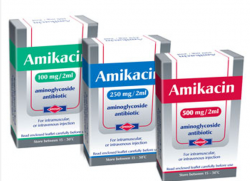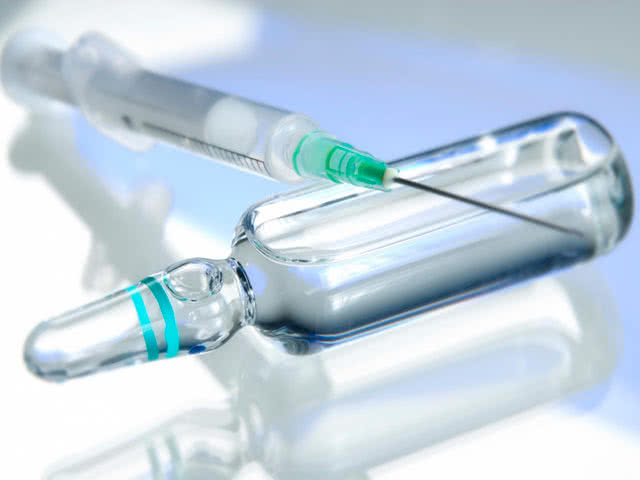Medicine Amikacin is an antibiotic that belongs to the group of aminoglycosides with a wide spectrum of bactericidal and anti-tuberculosis activity. Amikacin is not produced in tablets. It is sold only in the form of an injection solution and powder for preparing such a solution.
Description and pharmacological properties of AmikacinThe active substance of Amikacin is amikacin sulfate. Thanks to this, this medication is effective in the fight against gram-positive and gram-negative bacteria. Its action is based on destroying the bacterial membrane and preventing the formation of proteins. Because of this, Amikacin has maximum activity against bacteria such as:
- Klebsiella;
- salmonella;
- staphylococcus;
- gonococcus;
- streptococcus.
Amikacin for injections can only be purchased with a doctor's prescription. The shelf life of this medicine is 2 years. It is usually administered intramuscularly and is absorbed quickly and completely, but in some cases the administration can be by drip or jet within 1-2 minutes. Amikacin is also effective in the form of inhalations.
Indications for use of Amikacin
Indications for the use of Amikacin are almost all infectious and inflammatory diseases that are caused by gram-negative and gram-negative microorganisms or their associations. With this medication you can cure a variety of infections. respiratory tract:
- pneumonia;
- bronchitis;
- pleural empyema.
Also, indications for the use of Amikacin are infections of the biliary tract and central nervous system, including severe meningitis.
This medicine is used for:
- septic endocarditis;
- cystitis;
- urethritis;
- pyelonephritis and other infectious diseases of the genitourinary tract.
It will also help to cope with ulcers of the skin and soft tissues, for example, with:
- infected burns;
- ulcers and bedsores of various origins.
Amikacin can be used for intestinal infections, peritonitis and other infectious diseases abdominal cavity, as well as in the fight against various infections of bones and joints, wound and postoperative infections.
The use of Amikacin is also necessary for prostatitis, gonorrhea and tuberculosis (in combination with other drugs).
Contraindications to the use of Amikacin
Amikacin has many contraindications. It is strictly forbidden to take the drug if:
- severe diseases of all hematopoietic organs and the heart;
- pregnancy;
- neuritis of the auditory nerve;
- history of hypersensitivity to any components of the drug or other aminoglycosides;
- damage to the auditory or vestibular system;
- severe chronic renal failure, which is accompanied by azotemia and uremia.
Caution should be exercised when using Amikacin for pneumonia and various respiratory diseases during the neonatal period or for the treatment of premature infants and elderly patients. It is also worth avoiding Amikacin for myasthenia gravis, botulism and parkinsonism, as this medication can cause disruption of neuromuscular transmission.
Side effects of Amikacin
Most often, side effects of Amikacin occur from digestive system. This may include nausea, vomiting and liver dysfunction. In addition, after using this medication, severe headache and drowsiness may occur.
Very often, patients have an allergic reaction to Amikacin. It appears in the form: 
1.
2.
3.
4.
5.
The solution has an almost transparent color. The active ingredient of the drug is Amikacin. 1 ml of solution contains Amikacin 250 mg. Bottles of powder contain 1 gram. (500 mg) of the active ingredient, or 0.5 and 0.25 g. The drug is dispensed according to a doctor's prescription.
Application
Amikacin belongs to the aminoglycosides; it is a semisynthetic broad-spectrum antibiotic. Active against gram-negative aerobic microorganisms, at the same time able to fight some gram-positive microorganisms resistant to penicillin.
Prescribed to combat staphylococci, streptococci, pneumococci, tuberculosis bacteria, E. coli, etc.
After administration, the antibiotic is instantly absorbed and well distributed throughout all tissues and extracellular fluid of the body. Amikacin is observed in high concentrations in the kidneys, liver, spleen, and myocardium. Penetrates the placenta, is found in the blood of the fetus and in amniotic fluid. Maintains a therapeutic effect for 10-12 hours. It is excreted by the kidneys within 2-4 hours in adults, 3-4 hours in children, and 5-8 hours in newborns.
Amikacin: indications for use
Since Amikacin is a broad-spectrum antibiotic, it is used to treat infections of many body systems. In particular – genitourinary. Shows good therapeutic effect against prostatitis. The dosage of the drug for prostatitis is 250 mg twice a day. When treating prostatitis and other infections of the genitourinary system with Amikacin, patients are recommended to drink more fluids.
In other cases, the dosage of the drug for adults and children over 6 years of age is 7.5 mg/kg body weight 2 times a day, or 5 mg/kg 3 times a day. The maximum dose is 15 mg/kg body weight, but it should be taken into account that the daily dose of the drug should not exceed 1.5 g. The average course of treatment is a week.
Contraindications
Like any other drug, Amikacin can cause side effects and has its contraindications. May cause nausea and vomiting, drowsiness and headache, hearing loss, incoordination, renal dysfunction and allergic reactions.
The drug should not be used during pregnancy, severe renal failure, lactation, newborns and premature infants. In case of hypersensitivity to the components of the drug, or if such sensitivity has previously manifested itself to similar antibiotics. Treatment should be carried out as directed and preferably under the supervision of a doctor.
When treating prostatitis, Amikacin should not be combined with Erythromycin and Capreomycin, with vitamins B and C. The effect of the drugs is enhanced when used together with Carbenicillin, Benzylpenicillin, and cephalosporins. It can cause complications on the kidneys and hearing when combined with Vancomycin, Polymyxin, Nalidixic acid, Cisplatin.
Amikacin injections instructions

Amikacin injections are prescribed to combat diseases such as:
- Prostatitis, cystitis, gonorrhea, pyelonephritis, urethritis - infections of the genitourinary system.
- Pneumonia, bronchitis, pleurisy - respiratory infections.
- Burns, furunculosis, bedsores, osteomyelitis, trophic ulcers– skin diseases, infections of bones and soft tissues.
- Meningitis
- Sepsis
- Peritonitis
- Endocarditis
- Complications after operations.
For treatment outside the hospital, it is better to use ready-made solutions, since diluting powders requires some skills. If necessary, Amikacin can be replaced with its analogues. These are antibiotics such as Amicoside, Amicil, Canimax, Amitrex, Sifamik, Amica, Fabianol.
Prices for Amikacin injections vary - about $2 per injection.
J01GB06 (Amikacin)
Before using AMICACIN you should consult your doctor. These instructions for use are for informational purposes only. For more complete information, please refer to the manufacturer's instructions.
AMICACIN: Clinical and pharmacological group
06.015 (Antibiotic of the aminoglycoside group)
AMICACIN: Pharmacological action
Semi-synthetic antibiotic of the aminoglycoside group with a broad spectrum of action. Has a bactericidal effect. Actively penetrating the bacterial cell membrane, it irreversibly binds to the 30S subunit of bacterial ribosomes and, thereby, inhibits the synthesis of the pathogen protein.
Highly active against aerobic gram-negative bacteria: Pseudomonas aeruginosa, Escherichia coli, Shigella spp., Salmonella spp., Klebsiella spp., Enterobacter spp., Serratia spp., Providencia stuartii.
Also active against some gram-positive bacteria: Staphylococcus spp. (including strains resistant to penicillin, methicillin, some cephalosporins), some strains of Streptococcus spp.
Inactive against anaerobic bacteria.
AMICACIN: Pharmacokinetics
After intramuscular administration, it is quickly and completely absorbed. Distributed in all tissues of the body. Plasma protein binding is low (0-10%). Penetrates through the placental barrier.
Not metabolized. It is excreted unchanged in the urine. T1/2 - 2-4 hours.
AMICACIN: Dosage
They are determined individually, taking into account the severity and localization of the infection and the sensitivity of the pathogen. Administer intramuscularly, possibly also intravenously (stream for 2 minutes or drip).
IM or IV for adults and adolescents - 5 mg/kg every 8 hours or 7.5 mg/kg every 12 hours for 7-10 days. For children, the initial dose is 10 mg/kg, then 7.5 mg/kg every 12 hours.
Maximum doses: for adults, the daily dose is 1.5 g.
AMICACIN: Drug interactions
The risk of developing nephrotoxicity increases with simultaneous use of amikacin with amphotericin B, vancomycin, methoxyflurane, enflurane, NSAIDs, radiocontrast agents, cephalothin, cyclosporine, cisplatin, polymyxins.
The risk of developing ototoxicity increases with simultaneous use of amikacin with “loop” diuretics (, ethacrynic acid), cisplatin.
When used simultaneously with penicillins (in case of renal failure), the antimicrobial effect is reduced.
When used simultaneously with ethyl ether and neuromuscular transmission blockers, the risk of respiratory depression increases.
Amikacin in solution is incompatible with penicillins, cephalosporins, amphotericin B, chlorothiazide, erythromycin, heparin, thiopentone, and also, depending on the composition and concentration of the solution, with tetracyclines, B vitamins, vitamin C and potassium chloride.
AMICACIN: Pregnancy and lactation
Amikacin is contraindicated during pregnancy.
If it is necessary to use it during lactation, the issue of stopping breastfeeding should be decided.
AMICACIN: Side effects
From the digestive system: increased activity of liver transaminases, hyperbilirubinemia, nausea, vomiting.
Allergic reactions: skin rash, itching, fever; rarely - Quincke's edema.
From the hematopoietic system: anemia, leukopenia, granulocytopenia, thrombocytopenia.
From the central nervous system and peripheral nervous system: headache, drowsiness, impaired neuromuscular transmission, hearing loss, up to the development of irreversible deafness, vestibular disorders.
From the urinary system: oliguria, proteinuria, microhematuria; rarely - renal failure.
AMICACIN: Indications
Severe infectious and inflammatory diseases caused by microorganisms sensitive to amikacin: peritonitis, sepsis, neonatal sepsis, central nervous system infections (including meningitis), infections of bones and joints (including osteomyelitis), endocarditis, pneumonia, pleural empyema , lung abscess, purulent infections of the skin and soft tissues, infected burns, often recurrent urinary tract infections, biliary tract infections.
AMICACIN: Contraindications
Severe renal dysfunction, acoustic neuritis, pregnancy, hypersensitivity to aminoglycoside antibiotics.
AMICACIN: Special instructions
Use with caution in patients with myasthenia gravis and parkinsonism, as well as in the elderly.
The risk of developing ototoxic and nephrotoxic effects increases when amikacin is used in high doses or in predisposed patients.
AMICACIN: Use for renal impairment
Patients with impaired renal excretory function require adjustment of the dosage regimen depending on the CC values.
Many patients are interested in the question of how to dilute Amikacin in powder form to prepare a solution for intravenous and intramuscular injection. Amikacin is an aminoglycoside antibiotic with a broad spectrum of activity against gram-positive and gram-negative bacteria and should not be mixed with other antibacterial agents in one volume.
What and how to dilute Amikacin? A solution for intramuscular administration is prepared by adding 2-3 ml of water for injection to the contents of the bottle with the drug powder. When is Amikacin solution needed for intravenous administration(drip administration), the contents of the bottle are diluted with 200 ml of 5% glucose solution or isotonic sodium chloride solution at a concentration not exceeding 5 mg/ml. All solutions are prepared immediately before administration and used immediately after preparation.
For drip (intravenous diffusion) administration, the rate should be 60 drops per minute and the procedure time should reach 30-90 minutes. To do this, the volume of liquid is increased with glucose or sodium chloride. The intravenous injection of Amikacin should also be carried out very slowly (over 2–7 minutes).
The dosage of Amikacin depends on the age and body weight of the patient:
Adults and children over 6 years old - 5 mg/kg every 8 hours or 7.5 mg/kg every 12 hours. Maximum doses for adults - up to 15 mg/kg/day, but not more than 1.5 g/day for 10 days. The duration of treatment with intravenous administration is 3-7 days, with intramuscular administration - 7-10 days;
For premature newborns, the initial dose is 10 mg/kg, then 7.5 mg/kg every 18-24 hours;
- for newborns and children under 6 years of age, the initial dose is 10 mg/kg, then 7.5 mg/kg every 12 hours for 7-10 days.
Amikacin for children with intestinal infections
Infections of the abdominal cavity (including peritonitis), infections of the biliary tract in children are successfully treated with Amikacin solution.Infusion treatment (drip) of intestinal infections begins with the introduction colloidal solutions– fresh frozen plasma, Albumin, Reo-polyglucin, Hemodez, glucose-salt 5-10% solutions (potassium chloride, Quartasol, Trisol), etc. Antidiarrheal drugs and probiotics are introduced into the treatment complex.
The antibiotic Amikacin is prescribed only for moderate to severe forms of intestinal infections. The drug can have a toxic effect on the kidneys, which can lead to deafness. Therefore, we should try not to use them in patients childhood. If use cannot be avoided, Amikacin is administered to children with caution, slowly intravenously or intramuscularly once or twice a day. During the treatment period, it is necessary to take multivitamins.
Amikacin ampoule price
1 ampoule of Amikacin with 2 ml of injection solution contains amikacin sulfate 500 mg. Pack of 10 pcs. ampoule Shelf life: 3 years.Amikacin is an aminoglycoside antibiotic that disrupts the barrier functions of the cytoplasmic membranes of microbial cells. It is used to treat diseases such as: peritonitis, sepsis, meningitis, osteomyelitis, endocarditis, pneumonia, pleural empyema, lung abscess, severe infectious and inflammatory diseases.
The price of a package of Amikacin ampoules 500 mg, 2 ml, 10 pcs is 157 rubles.
Amikacin how to dilute with novocaine
An injection with Amikacin is very painful, so sometimes the drug is diluted with novocaine. Not all antibiotics are combined with novocaine, and besides, you need to know exactly the patient’s reaction to the novocaine test. If there is no allergy to novocaine, then Amikacin can be diluted with 0.5% novocaine 3 ml, but only for intramuscular administration. Reviews of medications, descriptions, medications, ratings of medications, instructions for use, user reviews, special instructions, side effects, overdose, application, indications1 reviews
Amikacin- a semisynthetic antibiotic that has wide range action, acts bactericidal. By binding to the 30S subunit of ribosomes, it prevents the formation of a transport and messenger RNA complex, blocks protein synthesis, and also destroys the cytoplasmic membranes of bacteria.Highly active against aerobic gram-negative microorganisms - Pseudomonas aeruginosa, Escherichia coli, Klebsiella spp., Serratia spp., Providencia spp., Enterobacter spp., Salmonella spp., Shigella spp.; some gram-positive microorganisms - Staphylococcus spp. (Including penicillin-resistant and some cephalosporins) moderately active against Streptococcus spp.
When administered simultaneously with benzylpenicillin, it has a synergistic effect against strains of Enterococcus faecalis.
Does not affect anaerobic microorganisms.
Amikacin does not lose activity under the action of enzymes, inactivate other aminoglycosides and can remain active against strains of Pseudomonas aeruginosa resistant to tobramycin, gentamicin and netromycin.
Indications for use:
Preparation Amikacin indicated for use in the treatment of infectious and inflammatory diseases caused by gram-negative microorganisms (resistant to gentamicin, sizomycin and kanamycin) or associations of gram-positive and gram-negative microorganisms:
- respiratory tract infections (bronchitis, pneumonia, pleural empyema, lung abscess);
- sepsis;
- septic endocarditis;
- central nervous system infections (including meningitis);
- abdominal infections (including peritonitis);
- genitourinary tract infections (pyelonephritis, cystitis, urethritis);
- purulent infections of the skin and soft tissues (including infected burns, infected ulcers and bedsores of various origins);
- biliary tract infections;
- infections of bones and joints (including osteomyelitis);
- wound infection;
- postoperative infections.
Directions for use:
Preparation Amikacin administered intramuscularly, intravenously (stream, over 2 minutes or drip) to adults and children over 6 years old - 5 mg/kg every 8 hours or 7.5 mg/kg every 12 hours. For bacterial urinary tract infections (uncomplicated ) - 250 mg every 12 hours; after a hemodialysis session, an additional dose of 3-5 mg/kg may be prescribed.
Maximum doses for adults are 15 mg/kg/day, but not more than 1.5 g/day for 10 days. The duration of treatment with intravenous administration is 3-7 days, with intramuscular administration - 7-10 days.
For infected burns, a dose of 5-7.5 mg/kg every 4-6 hours may be required due to the shorter T1/2 (1-1.5 hours) in this category of patients.
Amikacin is administered intravenously over 30-60 minutes, if necessary - in a stream.
For intravenous administration (drops), the drug is pre-diluted with 200 ml of 5% dextrose (glucose) solution or 0.9% sodium chloride solution. The concentration of amikacin in the solution for intravenous administration should not exceed 5 mg/ml.
If renal excretory function is impaired, it is necessary to reduce the dose or increase the intervals between doses. In case of increasing the interval between administrations (if the CC value is unknown and the patient’s condition is stable), the interval between administration of the drug is set according to the following formula:
interval (h) = serum creatinine concentration × 9.
If the serum creatinine concentration is 2 mg/dL, then the recommended single dose (7.5 mg/kg) must be administered every 18 hours. If the interval increases, the single dose does not change.
In the case of a reduction in a single dose with an unchanged dosage regimen, the first dose for patients with renal failure is 7.5 mg/kg. Subsequent doses are calculated using the following formula:
Subsequent dose (mg) administered every 12 hours = patient's CL (ml/min) × initial dose (mg)/normal CL (ml/min).
Side effects:
From the digestive system: nausea, vomiting, liver dysfunction (increased activity of liver transaminases, hyperbilirubinemia).
From the hematopoietic system: anemia, leukopenia, granulocytopenia, thrombocytopenia.
From the central nervous system and peripheral nervous system: headache, drowsiness, neurotoxic effects (muscle twitching, numbness, tingling, epileptic seizures), disruption of neuromuscular transmission (respiratory arrest).
From the senses: ototoxicity (hearing loss, vestibular and labyrinthine disorders, irreversible deafness), toxic effects on the vestibular apparatus (discoordination of movements, dizziness, nausea, vomiting).
From the urinary system: nephrotoxicity - impaired renal function (oliguria, proteinuria, microhematuria).
Allergic reactions: skin rash, itching, skin hyperemia, fever, Quincke's edema.
Local reactions: pain at the injection site, dermatitis, phlebitis and periphlebitis (with intravenous administration).
Contraindications:
Indications for use of the drug Amikacin are: acoustic neuritis; severe chronic renal failure with azotemia and uremia; pregnancy; hypersensitivity to the components of the drug; history of hypersensitivity to other aminoglycosides.
The drug should be used with caution in case of myasthenia gravis, parkinsonism, botulism (aminoglycosides can cause disruption of neuromuscular transmission, which leads to further weakening of skeletal muscles), dehydration, renal failure, in the neonatal period, in premature infants, in elderly patients, during lactation.
Pregnancy:
Preparation Amikacin contraindicated during pregnancy.
If there are vital indications, the drug can be used in nursing women. It should be borne in mind that aminoglycosides are released from breast milk in small quantities. They are poorly absorbed from the gastrointestinal tract, and complications associated with them have not been recorded in infants.
Interaction with other drugs:
Amikacin exhibits synergism when interacting with carbenicillin, benzylpenicillin, cephalosporins (in patients with severe chronic renal failure, when used together with beta-lactam antibiotics, the effectiveness of aminoglycosides may be reduced).
Nalidixic acid, polymyxin B, cisplatin and vancomycin increase the risk of developing oto- and nephrotoxicity.
Diuretics (especially furosemide), cephalosporins, penicillins, sulfonamides and NSAIDs, competing for active secretion in the nephron tubules, block the elimination of aminoglycosides, increase their concentration in the blood serum, increasing nephro- and neurotoxicity.
Amikacin enhances the muscle relaxant effect of curare-like drugs.
When used simultaneously with amikacin, methoxyflurane, polymyxins for parenteral administration, capreomycin and other drugs that block neuromuscular transmission (halogenated hydrocarbons - inhalation anesthesia agents, opioid analgesics), transfusion large quantity blood with citrate preservatives increases the risk of respiratory arrest.
Parenteral administration of indomethacin increases the risk of developing toxic effects of aminoglycosides (increased T1/2 and decreased clearance).
Amikacin reduces the effectiveness of antimyasthenic drugs.
Pharmaceutically incompatible with penicillins, heparin, cephalosporins, capreomycin, amphotericin B, hydrochlorothiazide, erythromycin, nitrofurantoin, vitamins B and C, potassium chloride.
Overdose:
Symptoms of drug overdose Amikacin: toxic reactions - hearing loss, ataxia, dizziness, urination disorders, thirst, loss of appetite, nausea, vomiting, ringing or a feeling of stuffiness in the ears, breathing problems.
Treatment: to relieve the blockade of neuromuscular transmission and its consequences - hemodialysis or peritoneal dialysis; anticholinesterase drugs, calcium salts, mechanical ventilation, other symptomatic and supportive therapy.
Storage conditions:
List B. Drug Amikacin should be stored out of the reach of children, in a dry place, protected from light at a temperature of 5° to 25°C. Shelf life - 2 years.
Release form:
Amikacin - solution for intravenous and intramuscular administration of 500 mg/2 ml: amp. 5 or 10 pcs.
Compound:
1 ml - 1 ampoule of Amikacin contains: amikacin (in the form of sulfate) 250 mg 500 mg.
Excipients: sodium disulfite (sodium metabisulfite), sodium citrate for injection (sodium citrate pentasesquihydrate), diluted sulfuric acid, water for injection.
Additionally:
Before use Amikacin determine the sensitivity of isolated pathogens using disks containing 30 μg of amikacin. With a diameter of the growth-free zone of 17 mm or more, the microorganism is considered sensitive, from 15 to 16 mm - moderately sensitive, less than 14 mm - resistant.
The concentration of amikacin in plasma should not exceed 25 mcg/ml (a concentration of 15-25 mcg/ml is therapeutic).
During the treatment period, it is necessary to monitor the function of the kidneys, auditory nerve and vestibular apparatus at least once a week.
The likelihood of developing nephrotoxicity is higher in patients with impaired renal function, as well as when prescribing high doses or for a long time (in these patients, daily monitoring of renal function may be required).
If audiometric tests are unsatisfactory, the dose of the drug is reduced or treatment is stopped.
Patients with infectious and inflammatory diseases of the urinary tract are recommended to take increased amounts of fluid with adequate diuresis.
In the absence of positive clinical dynamics, one should remember the possibility of the development of resistant microorganisms. In such cases, it is necessary to discontinue treatment and begin appropriate therapy.
The sodium disulfite contained in the drug can cause the development of allergic complications in patients (including anaphylactic reactions), especially in patients with an allergic history.
Use is contraindicated in severe chronic renal failure with azotemia and uremia.
If renal excretory function is impaired, dosage regimen adjustment is required.
For premature newborns, the initial single dose is 10 mg/kg, then 7.5 mg/kg every 18-24 hours; for newborns and children under 6 years of age, the initial dose is 10 mg/kg, then 7.5 mg/kg every 12 hours for 7-10 days.
The drug should be used with caution in elderly patients.





